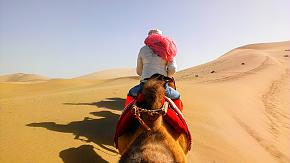How to Plan a Silk Road Trip in China
For 1,200 years, from the 2nd century BC to the 10th century AD, merchants with big dreams traveled between China and the Roman Empire along the ancient Silk Road, which not only prospered the silk, spice, and jewelry trade between the East and the West but also promoted the exchange and integration of Eastern and Western culture, religion, and art. In the 15th century, with the rise of the Maritime Silk Road, this ancient land trade route gradually declined.
However, along the road, many cities, like Xi'an, Dunhuang, and Kashgar, still exude charming brilliance due to their colorful human and natural landscapes, making them ideal destinations for a Silk Road tour in China.
Where to Start the Silk Road Trip?
 Camel ride on the Silk Road trip in China
Camel ride on the Silk Road trip in China
As the starting point of the Ancient Silk Road, Xi'an (formerly known as Chang'an), with a developed international and domestic transportation network, is the best place to embark on your exploration of the China Silk Road.
Air transportation
About 40 kilometers from the city center, Xi'an Xianyang International Airport hosts direct flights to many cities in North America, Oceania, Europe, and other Asian countries. With the advancement of the "Belt and Road" initiative, the number of international routes has continued to increase. At the same time, it also has stable flights to other important cities on the Silk Road, such as Dunhuang, Lanzhou, and Urumqi.
High-speed Trains
Although high-speed rail mainly serves domestic travel, Xi'an, as a high-speed rail hub city, connects many other major cities in China, which allows international travelers to transfer through cities like Beijing, Shanghai, Hong Kong, Chengdu, or other cities and then take the high-speed rail to Xi'an quickly. It is also convenient to take the high-speed rail from Xi'an to the rest areas on the Silk Road, such as Gansu and Xinjiang.
Recommended Places for a China Silk Road Tour
1. Xi'an
 Terracotta Warriors in Xi'an
Terracotta Warriors in Xi'an
As the starting point of the Silk Road, Xi'an is an ideal place to start your ancient Silk Road journey. Besides the world-famous Terracotta Warriors and Horses of Qin Shi Huang's Mausoleum, in this millenarian city, you will find countless other historical sites in this city, such as the 600-year-old Ming City Wall, the Big Wild Goose Pagoda dating back to the 7th century AD, and many imperial tombs, including the Han Yang Tomb and the Qianling Mausoleum of Wu Zetian, the only female emperor in Chinese history.
Some emerging attractions, such as the Great Tang All Day Mall, also attract countless people favoring Han and Tang costumes.
In addition, 120 kilometers northeast of Xi'an, Mount Huashan, one of the famous Five Mountains in China, is the destination for outdoor adventurers who like to challenge its steep mountains and thrilling climbing trails.
2. Lanzhou
 The Yellow River Mother Statue in Lanzhou
The Yellow River Mother Statue in Lanzhou
Lanzhou, located in the upper reaches of the Yellow River, was an important node on the ancient Silk Road and the Hexi Corridor. Today, it is still a gateway to and from Northwest China. From here, you can take a plane, high-speed train, or road trip to most other important cities on the Silk Road.
While in Lanzhou, you don't want to miss the Bingling Temple Grottoes, located 80 kilometers from the city. Carved into the cliffs along the Yellow River since 420 AD, it's a spectacular Buddhist art sanctuary with hundreds of caves, Buddha statues, and countless exquisite murals. Visitors to the caves must take a boat from the Liujiaxia Reservoir Pier, during which you can enjoy the magnificent scenery along the Yellow River, especially when the water encounters flaming Danxia landforms.
If time permits, you can spend half a day strolling along the Yellow River Scenic Line in the city. This riverside sightseeing belt built along the Yellow River is a good place for Lanzhou citizens and tourists to relax and have fun. There are many attractions along the way, such as Zhongshan Bridge, Baitashan Park, Waterwheel Park, and the Yellow River Mother Statue.
In addition, its foods, such as Lanzhou beef noodles, hand-pulled lamb, and milk-fermented glutinous rice, are also must-try.
3. Xining
 The Ta'er Temple in Xining
The Ta'er Temple in Xining
Located on the northeastern edge of the Qinghai-Tibet Plateau, Xining is not part of the main route of the ancient Silk Road, but the intersection of the southern route of the Silk Road and the Tang-Tibet Ancient Road (a historical passage connecting Tubo-now Tibet and the Tang Dynasty between the 7th and 10th centuries).
Here, you can visit the Ta'er Monastery, one of the six major monasteries of Tibetan Buddhism, the Xiguan Grand Mosque with traditional Chinese and Islamic architectural elements, and the beautiful Qinghai Lake, China's largest inland saltwater lake.
Nowadays, Xining is a popular destination as the starting point of the Qinghai-Tibet Railway and some luxury train trips, such as the Silk Road Express.
4. Zhangye
 Zhangye Danxia National Geopark
Zhangye Danxia National Geopark
Sitting in the heart of the Hexi Corridor, Zhangye boasts many historical heritage sites, like the Great Buddha Temple and the Mati Temple Grottoes. However, the colorful Danxia landforms are the star shining most here.
Zhangye Danxia National Geopark is known as one of the most beautiful Danxia landforms in the world. The mountains and rocks here are colorful and well-layered, forming a magnificent natural landscape. Binggou Danxia, adjacent to the Zhangye Danxia landform, is even steeper and more majestic.
In addition, with Han, Tibetan, Yugur, Hui, and some other ethnic groups living here together, it is also a place to take in diverse ethnic cultures.
5. Jiayuguan
 Jiayuguan Great Wall
Jiayuguan Great Wall
As the western starting point of the ancient Great Wall of China and a strategic military fortress on the Silk Road, Jiayuguan has majestic fortification buildings and rich historical relics, including Jiayuguan Pass, a military defense system with sophisticated design and complete facilities, and the Hanging Wall Great Wall.
6. Dunhuang
 The Mogao Grottoes in Dunhuang
The Mogao Grottoes in Dunhuang
Dunhuang is the western end of the Hexi Corridor. From here, you will soon enter the Western Regions referred to in Chinese history, including the vast land of Xinjiang and central Asia.
Since the 4th century, Dunhuang has become one of the Buddhist centers, attracting multitudes of monks, artists, and scholars and preserving countless heritages integrating cultural elements from the Western Regions, India, Persia, and other places.
The UNESOC-listed Mogao Grottoes, housing myriads of exquisite murals and colored sculptures, are one of the most content-rich Buddhist art treasures on earth.
In addition, Mingsha Mountain and Crescent Lake, Yangguan Pass, Yumen Pass, and Yadan Geopark are also worth a visit.
7. Turpan
 Jiaohe Ancient City in Turpan
Jiaohe Ancient City in Turpan
The Turpan Basin is the lowest point in China's mainland and the third lowest in the world after the Dead Sea and Lake Assal. On the ancient Silk Road, Turpan's oasis provided water and rest areas for caravans and served as a meeting point for multiple religions such as Buddhism, Zoroastrianism (Zoroastrianism), and Nestorianism (Christianity), becoming a microcosm of the intersection of Eastern and Western civilizations. The main sites here include:
The Jiaohe Ancient City, over 2,000 years old, is a large urban site with well-preserved earthen buildings, including palaces, temples, and residences, reflecting the prosperity of ancient Turpan.
The Gaochang Ancient City, built in the 1st century BC, integrates multiple cultures and preserves a large number of Buddhist temple sites and murals.
Turpan's underground water conservancy project, qanat or kārīz, brings snow-capped mountain meltwater into the oasis through underground channels to irrigate farmland, solving the water problem in dry and hot Turpan, nicknamed China's Fire Land.
8. Urumqi
 Tianchi Lake in Urumqi
Tianchi Lake in Urumqi
Although not the central city of the Silk Road, as the political, economic, and cultural center of Xinjiang, Urumqi is an important transit point for tourists on the Silk Road journey today.
In addition to the magnificent Red Mountain and Tianshan Lake, you will also find the world's largest bazaar here. From Urumqui, there are direct flights to Central and West Asian cities, such as Almaty, Bishkek, Dushanbe, Tehran, Tbilisi, Baku, Islamabad, Tashkent, etc.
9. Kashgar
 Id Kah Mosque in Kashgar
Id Kah Mosque in Kashgar
As the intersection of the southern and western routes of the time-honored Silk Road, Kashgar connected several trade routes to Central Asia, especially to today's Tajikistan, Afghanistan, Pakistan, and India. Even today, Kashgar is still a gateway from China to the western land, from which tourists can travel by land to Central Asia through multiple land ports and complete the entire Silk Road to Istanbul or Rome.
Here, you can visit the Id Kah Mosque, the Tomb of the Fragrant Concubine, and the Old City of Kashgar, gain an in-depth understanding of Kashgar's religious culture and long history, and experience the traditional lifestyle of the Uyghurs; visit the Kashgar Grand Bazaar, experience the lively market atmosphere, buy handicrafts with local characteristics, and taste authentic Uyghur cuisine; go to Karakul Lake and Muztagh Ata Peak to feel the magnificent scenery of the plateau and the magnificence of the glaciers, and experience the natural scenery completely different from the city style of Kashgar.
Besides the above, there are some low-key post stations on the Silk Road, such as Tianshui, Wuwei, etc.
Suggestions for your China Silk Road Trip
 The Gaochang Ancient City
The Gaochang Ancient City
Planning a trip along the Silk Road in China will allow you to gain a deeper understanding of the rich history and culture, magnificent natural scenery, and diverse ethnic customs of western China. The following suggestions may help you make a better plan.
Travel Route and Length
If you're visiting China for the first time and wish to include a brief Silk Road experience, a 5–6-day itinerary focusing on Xi'an and Dunhuang is ideal.
For a deeper exploration, consider traveling from Xi'an to Dunhuang by air, spending 2-3 nights there. Then, take a scenic 5-6 hour train ride to Turpan for two days. Next, fly to Kashgar for another 2-3 days of discovery.
For those passionate about history, art, nature, and photography, we suggest a comprehensive route encompassing Xi'an, Tianshui, Lanzhou, Zhangye, Jiayuguan, Dunhuang, Turpan, Urumqi, and Kashgar. This immersive journey requires a minimum of two weeks. From Kashgar, you can continue westward into Central Asia to explore other regions along the Silk Road.
For those interested in delving deeper into southern Xinjiang, including cities like Korla, Kuche, and Aksu, and possibly crossing the Taklimakan Desert, consider allocating a month or more time.
Click here to pick up your favorite itinerary.
Travel Times and Tips
- Best Time: May to October is usually the best time to travel along the Silk Road, with pleasant weather and beautiful scenery. However, it is wise to avoid July and August for the crazy crowds during the summer vacation.
- Sunscreen and warm clothing: Due to the changeable climate along the Silk Road, it is important to prepare sunscreen, hats, sunglasses, and warm clothes (even in summer), especially in deserts and mountainous areas.
- Drinking water and food safety: Choose clean and hygienic restaurants to eat, avoid raw and cold food, and carry bottled water with you.
- Health check and insurance: Before long-distance travel, conduct necessary health checks and purchase travel insurance in case of any emergency during the trip.
- Respect for local culture: Understand and respect local culture and customs, such as taking off shoes and wearing long skirts/trousers when entering a mosque.
Plan Your Tour With Us
For more information or a bespoke plan, please contact our Silk Road travel experts.
Related Posts You May Like
What Our Clients Say
"Great Customized Service", "Trip of A Lifetime", "Exceed All Expectations"















